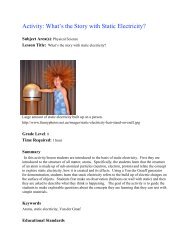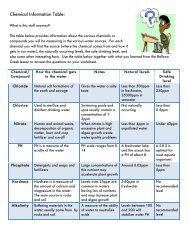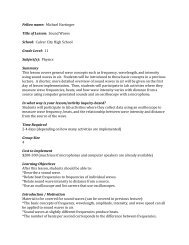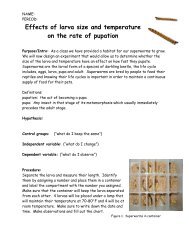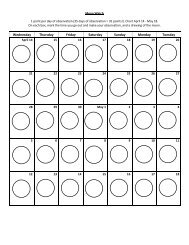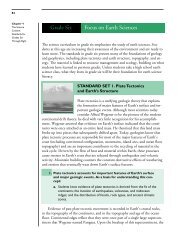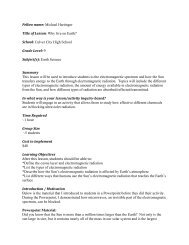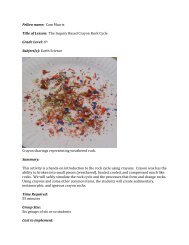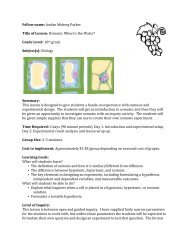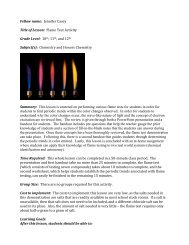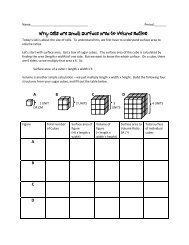Fellow name: Kris Kaiser Title of Lesson: Declining Amphibians ...
Fellow name: Kris Kaiser Title of Lesson: Declining Amphibians ...
Fellow name: Kris Kaiser Title of Lesson: Declining Amphibians ...
You also want an ePaper? Increase the reach of your titles
YUMPU automatically turns print PDFs into web optimized ePapers that Google loves.
<strong>Fellow</strong> <strong>name</strong>: <strong>Kris</strong> <strong>Kaiser</strong> <br />
<br />
<strong>Title</strong> <strong>of</strong> <strong>Lesson</strong>: <strong>Declining</strong> <strong>Amphibians</strong>: Where have all the frogs gone? <br />
<br />
School: Culver City High School <br />
<br />
Grade Level: 9 (9‐12) <br />
<br />
Subject(s): Biology <br />
<br />
<br />
Summary <br />
In this lesson, students learn about global amphibian declines, and how they relate to <br />
human changes to environments. The lesson starts with a lecture on amphibians, which <br />
differentiates amphibians from reptiles and introduces students to very basic amphibian <br />
biology, to help them understand why they may be more likely to decline than other <br />
vertebrate groups, and introduced to the concept <strong>of</strong> amphibian declines. After that, <br />
students are broken into groups, and given one potential cause for amphibian declines. <br />
They are to act as scientists, read the information given, and determine whether they think <br />
their assigned factor is a significant cause for global amphibians. On the final day, students <br />
hold a debate or town hall meeting, where they present their evidence for or against their <br />
factor. <br />
<br />
In what way is your lesson/activity inquirybased? <br />
Students are given non‐biased information with information about the assigned factor, and <br />
it is their job to act as a scientist to interpret it and present it to the class and justify it. <br />
<br />
Time Required <br />
Four 50‐minute class periods; more or less depending on amount <strong>of</strong> work assigned outside <br />
<strong>of</strong> class; short discussion (10‐15 minutes) on fifth day; may be fit into debate day if debate <br />
runs short. <br />
<br />
Group Size <br />
Approximately 4 students <br />
<br />
Cost to implement <br />
$10/class <br />
<br />
Learning Objectives <br />
After this lesson, students should be able to: <br />
‐Explain the difference between amphibians and reptiles <br />
‐List and describe several causes for amphibian declines <br />
‐Explain what makes amphibians susceptible to declines than other vertebrates <br />
‐Relate the causes <strong>of</strong> amphibian declines to human changes to the environment, and how <br />
these changes can affect all <strong>of</strong> biodiversity <br />
‐Define terms such as metamorphosis and indicator species.
<br />
Introduction / Motivation <br />
Not provided <br />
<br />
Procedure <br />
<br />
Day 1: <br />
Power Point Lecture on <strong>Amphibians</strong> and Reptiles / Introduction to Amphibian Declines <br />
<br />
Day 2/3: <br />
Students are broken into groups and assigned topic for debate, and given grading rubric. <br />
Students may need more time, and some <strong>of</strong> ours came in at lunch or after school. If an extra <br />
day is warranted, or if you want to give students time to do extra research online, build it in <br />
here. Students should be warned that they will NOT be given time to work on projects in <br />
class the day <strong>of</strong> the debate. Each team should also be given a second role to look at and <br />
familiarize themselves with. They will not present this information, but they will “keep the <br />
other team honest.” Let them know they are specifically in charge <strong>of</strong> asking that particular <br />
team questions, as they have information, though they can ask any team questions. Point <br />
out that this means that each team has some <strong>of</strong> their information, as well, so they need to <br />
know their material. You can give them the full sheet or the slightly pared‐down <br />
“secondary role” version. It helps if students take notes. <br />
<br />
Day 4: <br />
Students hold debate. We required each student to speak. Presentations were 2‐3 <br />
minutes, maximum. <br />
<br />
Day 5: <br />
Short discussion on reflections on the debate. Ask students what the main cause <strong>of</strong> declines <br />
is. Allow several students to answer. If no one says “humans,” see if students can see that <br />
humans are the common thread behind all <strong>of</strong> the causes. Assign reflection. <br />
<br />
Debate: Each group presents their project, and then other students are allowed to ask <br />
questions. Teams are judged partly on their ability to field questions (within reason). <br />
Students are graded on participation, i.e., asking questions during the debate. In addition to <br />
their topic, each group has been given a small amount <strong>of</strong> information on a secondary topic, <br />
so each group that presents has another team who knows something about their topic and <br />
should be able to ask informed questions even if no one else participates. <br />
<br />
Optional: Students expressed an interest in being able to do presentations with visual aids <br />
other than just posters. One option is to allow students to present their work using <br />
different media at your discretion, as long as it meets the grading criteria. <br />
<br />
Also optional: focus question/question <strong>of</strong> the day / warm up each day, if used, can <br />
incorporate the lesson: <br />
Day 1 (lecture) – (warm up for day 2 or focus for that day): List 3‐5 new things you learned <br />
during the lecture. <br />
Day 2: Summarize your primary factor for the amphibian decline project. <br />
Day 3: Summarize your secondary factor for the amphibian decline project. <br />
Day 4 (Debate): Do you think there is one major factor causing amphibian declines? <br />
Explain. <br />
<br />
<br />
Materials List <br />
Each group will need: <br />
1 Poster board <br />
Art supplies <br />
Optional: Printer, computer with internet access; Power Point; other media for students to <br />
create presentations <br />
<br />
To share with the entire class: <br />
One classroom set <strong>of</strong> grading rubrics, Copies <strong>of</strong> one amphibian decline for each team, <br />
ideally in protective plastic sleeves. If copies are limited, allow students to take handouts <br />
home by request only. <br />
<br />
Safety Issues <br />
None <br />
<br />
<strong>Lesson</strong> Closure <br />
Short discussion on the final day closes the lesson, and then the reflection assignment <br />
allows assessment <strong>of</strong> whether students really grasped the concepts. <br />
<br />
Is this lesson based upon or modified from existing materials? If yes, please specify <br />
source(s) and explain how related: <br />
Parts <strong>of</strong> scenarios are based loosely on the Case <strong>of</strong> the Missing Anurans. <br />
<br />
<br />
References <br />
www.hamline.edu/cgee/frogs/teachers/activity/Case<strong>of</strong>MA.pdf<br />
http://www.uoregon.edu/~titus/herp/documents/girardeau.html<br />
http://amphibiaweb.org/declines/IntroSp.html<br />
http://www.frogsaustralia.net.au/conservation/cane-toads.cfm<br />
http://www.saracooks.com/articles/20021222_001.html<br />
<br />
<br />
Attachments <br />
<strong>Kaiser</strong> where have all the frogs gone.ppt – lecture slides <br />
Amphibian Population Declines Background Info.doc – handout for students <br />
Amphibian Decline Project Written Reflection.doc – <strong>Lesson</strong> wrap up assignment <br />
amphibian decline town hall rubric.doc – Grading rubric <br />
amphibian decline town hall roles.doc – Team roles
amphibian decline town hall secondary roles.doc <br />
<br />
<br />
List CA Science Standards addressed: <br />
6. Stability in an ecosystem is a balance between competing effects.<br />
As a basis for understanding this concept:<br />
a. Students know biodiversity is the sum total <strong>of</strong> different kinds <strong>of</strong><br />
organisms and is affected by alterations <strong>of</strong> habitats.<br />
b. Students know how to analyze changes in an ecosystem resulting from changes in<br />
climate, human activity, introduction <strong>of</strong> nonnative species, or changes in population<br />
size.<br />
<br />
<br />
<br />
<strong>Lesson</strong> Implementation Comments <br />
<br />
The students were overwhelmingly positive in the reflection <strong>of</strong> the project. They really enjoyed<br />
it, and because it’s something with animals, and something out <strong>of</strong> the ordinary, they got into it.<br />
The quiet kids, the artistic kids, the girls, they all loved it, surprisingly enough. Kids that<br />
normally don’t really like biology, loved it. One kid called it hands down his favorite project<br />
he’d ever done.



